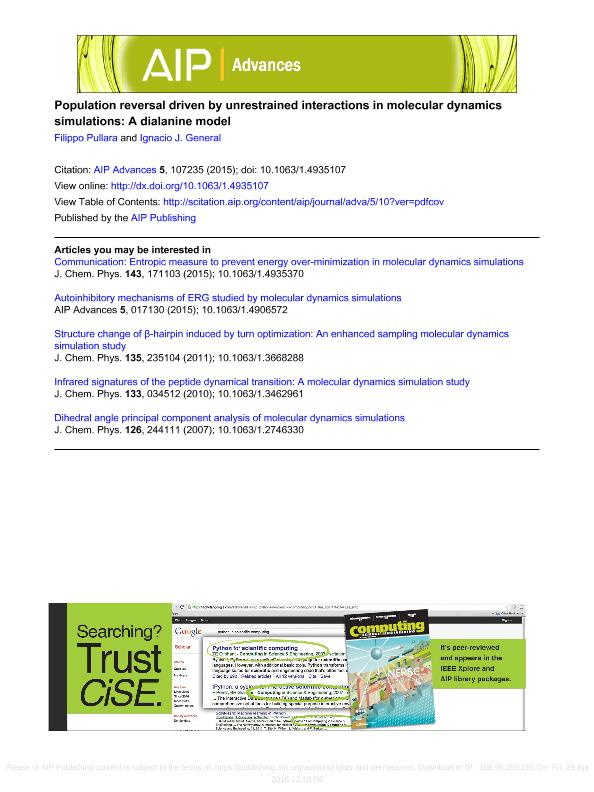Mostrar el registro sencillo del ítem
dc.contributor.author
Pullara, Filippo
dc.contributor.author
General, Ignacio

dc.date.available
2019-02-11T17:26:26Z
dc.date.issued
2015-10
dc.identifier.citation
Pullara, Filippo; General, Ignacio; Population reversal driven by unrestrained interactions in molecular dynamics simulations: A dialanine model; American Institute of Physics; AIP Advances; 5; 10; 10-2015; 1-8; 107235
dc.identifier.issn
2158-3226
dc.identifier.uri
http://hdl.handle.net/11336/69848
dc.description.abstract
Standard Molecular Dynamics simulations (MD) are usually performed under periodic boundary conditions using the well-established "Ewald summation". This implies that the distance among each element in a given lattice cell and its corresponding element in another cell, as well as their relative orientations, are constant. Consequently, protein-protein interactions between proteins in different cells - important in many biological activities, such as protein cooperativity and physiological/pathological aggregation - are severely restricted, and features driven by protein-protein interactions are lost. The consequences of these restrictions, although conceptually understood and mentioned in the literature, have not been quantitatively studied before. The effect of protein-protein interactions on the free energy landscape of a model system, dialanine, is presented. This simple system features a free energy diagram with well-separated minima. It is found that, in the case of absence of peptide-peptide (p-p) interactions, the ψ = 150° dihedral angle determines the most energetically favored conformation (global free-energy minimum). When strong p-p interactions are induced, the global minimum switches to the ψ = 0° conformation. This shows that the free-energy landscape of an individual molecule is dramatically affected by the presence of other freely interacting molecules of its same type. Results of the study suggest how taking into account p-p interactions in MD allows having a more realistic picture of system activity and functional conformations.
dc.format
application/pdf
dc.language.iso
eng
dc.publisher
American Institute of Physics

dc.rights
info:eu-repo/semantics/openAccess
dc.rights.uri
https://creativecommons.org/licenses/by-nc-sa/2.5/ar/
dc.subject
Free Energy
dc.subject
Protein Protein Interactions
dc.subject
Electric Dipole Moments
dc.subject
Peptides
dc.subject.classification
Otras Ciencias Físicas

dc.subject.classification
Ciencias Físicas

dc.subject.classification
CIENCIAS NATURALES Y EXACTAS

dc.title
Population reversal driven by unrestrained interactions in molecular dynamics simulations: A dialanine model
dc.type
info:eu-repo/semantics/article
dc.type
info:ar-repo/semantics/artículo
dc.type
info:eu-repo/semantics/publishedVersion
dc.date.updated
2019-02-11T13:48:46Z
dc.journal.volume
5
dc.journal.number
10
dc.journal.pagination
1-8; 107235
dc.journal.pais
Estados Unidos

dc.description.fil
Fil: Pullara, Filippo. University of Pittsburgh; Estados Unidos. Fondazione RiMED; Italia
dc.description.fil
Fil: General, Ignacio. Universidad Nacional de San Martín. Escuela de Ciencia y Tecnología; Argentina. Consejo Nacional de Investigaciones Científicas y Técnicas; Argentina
dc.journal.title
AIP Advances
dc.relation.alternativeid
info:eu-repo/semantics/altIdentifier/doi/http://dx.doi.org/10.1063/1.4935107
dc.relation.alternativeid
info:eu-repo/semantics/altIdentifier/url/https://aip.scitation.org/doi/10.1063/1.4935107
Archivos asociados
